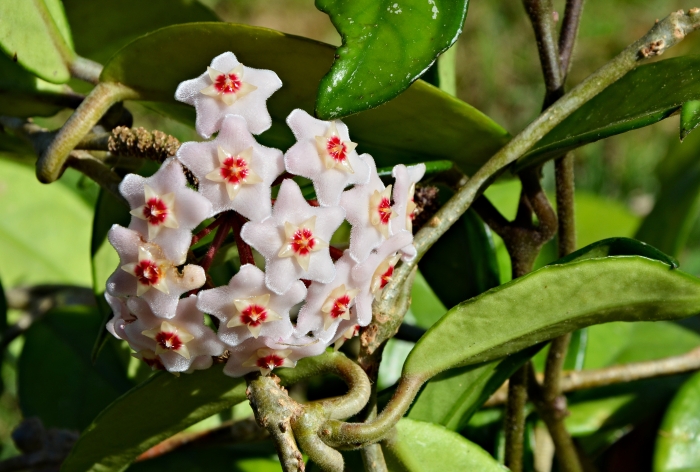Porcelainflower
(Hoya carnosa)
Porcelainflower (Hoya carnosa)
/
/

JLPC
CC BY-SA 3.0
Image By:
JLPC
Recorded By:
Copyright:
CC BY-SA 3.0
Copyright Notice:
Photo by: JLPC | License Type: CC BY-SA 3.0 | License URL: https://creativecommons.org/licenses/by-sa/3.0 | Uploader: JLPC | Publisher: Wikimedia Commons | Title: Hoya_FR_2013.jpg |

















Estimated Native Range
Summary
Hoya carnosa, commonly known as Porcelainflower, is an evergreen perennial vine native to Southeast Asia, China, Taiwan and Japan, specifically found in rainforests, coastal bush, and along stream banks. It is a popular houseplant valued for its attractive waxy foliage and clusters of sweetly scented flowers. The plant can reach lengths of several meters when supported, with leaves that are thick, waxy, and typically a deep green. The inflorescences consist of multiple star-shaped flowers, ranging from near-white to dark pink, and are particularly noted for their porcelain-like appearance. These flowers are highly ornamental, with a fuzzy sheen due to tiny hairs, and they produce a noticeable fragrance and excess nectar. Flowering occurs from spring to late summer, with the blooms being especially showy.
Porcelainflower is favored for its ease of maintenance and adaptability to indoor conditions, thriving in bright indirect light but tolerating lower light levels. It is often grown in pots and hanging baskets, making it an excellent choice for vertical gardening. The plant prefers warm temperatures between 60–85 °F (16–29 °C) and should not be exposed to freezing conditions. It requires a well-draining potting mix, ideally with components like perlite, pumice, or ceramic balls to ensure root aeration. Regular feeding with a fertilizer formulated for epiphytic plants is recommended. While it is generally pest-resistant, mealybugs and aphids can sometimes be a problem. Overwatering can lead to root rot, so it is essential to allow the soil to dry out between waterings. Propagation is easily achieved through air layering or stem cuttings.CC BY-SA 4.0
Porcelainflower is favored for its ease of maintenance and adaptability to indoor conditions, thriving in bright indirect light but tolerating lower light levels. It is often grown in pots and hanging baskets, making it an excellent choice for vertical gardening. The plant prefers warm temperatures between 60–85 °F (16–29 °C) and should not be exposed to freezing conditions. It requires a well-draining potting mix, ideally with components like perlite, pumice, or ceramic balls to ensure root aeration. Regular feeding with a fertilizer formulated for epiphytic plants is recommended. While it is generally pest-resistant, mealybugs and aphids can sometimes be a problem. Overwatering can lead to root rot, so it is essential to allow the soil to dry out between waterings. Propagation is easily achieved through air layering or stem cuttings.CC BY-SA 4.0
Plant Description
- Plant Type: Vine
- Height: 2-4 feet
- Width: 1-2 feet
- Growth Rate: Moderate
- Flower Color: Pink, Red, White
- Flowering Season: Spring, Summer
- Leaf Retention: Evergreen
Growth Requirements
- Sun: Full Sun, Part Shade
- Water: Medium
- Drainage: Fast
Common Uses
Bee Garden, Bird Garden, Butterfly Garden, Fragrant, Hummingbird Garden, Potted Plant, Showy Flowers
Natural Habitat
native to Southeast Asia, China, Taiwan and Japan, specifically found in rainforests, coastal bush, and along stream banks
Other Names
Common Names: Honeyplant, Waxflower, Waxplant, Porzellanblume, Porslinsblomma, Mata De Cera, Wax Plant, Qiu Lan, 호야
Scientific Names: , Hoya carnosa, Hoya motoskei, Hoya rotundifolia, Hoya picta, Hoya variegata, Hoya intermedia, Asclepias carnosa, Hoya chinensis, Hoya crassifolia
GBIF Accepted Name: Hoya carnosa (L.fil.) R.Br.